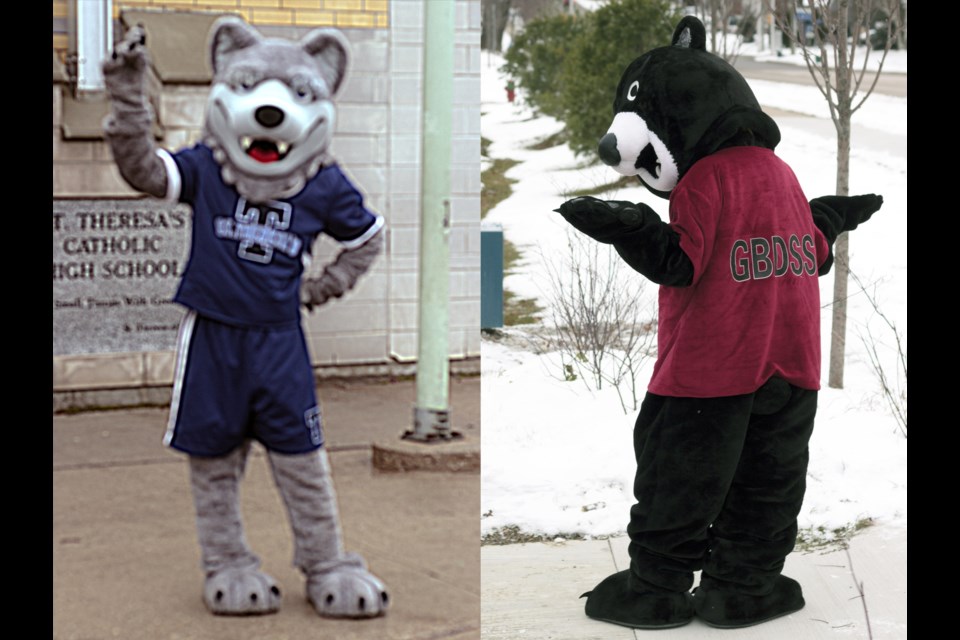Sports teams are often comprised of countless participants, from just a handful at the small-time amateur level, to upward of hundreds in the global levels.
Players, coaches, physicians, trainers and so many other members band together cohesively into a single team entity for the entertainment of fans everywhere.
Mascots are personifications of those teams. They are the single distilled essence of those teams. A fan doesn’t need clinical awareness toward any of the stats or even to know the names of players or staff in a given team to understand that a colourful, fuzzy goofball wearing a team jersey on the field is someone deserving of their cheers.
“(Our mascot is) an integral part of our school,” said Dan Pellarin, a guidance counsellor at St. Theresa’s Catholic High School.
Storm the Thunder Wolf is the mascot for St. Theresa’s, having been introduced in 2013 to the student body, and named by students prior to the revelation.
The St. Theresa’s mascot hosts anyone who is chosen to don the suit, whether they be staff or student alike. Although Storm was the brainchild of English teacher Sean Sparks during the development phase, the first person to perform as Storm was George Luck, then the vice-principal and now current principal.
“(Storm) is around multiple events,” explained Pellarin, “so when we have assemblies, sporting events, Grade 8 transitions, parent-teacher nights; it’s around even during the day when we do things like uniform checks.”
Both Midland and Penetanguishene have their shared histories of mascots facing off against one another, with Storm in St. Theresa’s, and the two local high schools which amalgamated into Georgian Bay District Secondary School in 2015.
“Penetang Secondary School had been the Pride, and their mascot had been a lion with red-and-white colours,” said Betony Main, a drama and teacher-librarian with GBDSS, “and Midland Secondary School were the Marauders with blue-and-yellow.”
GBDSS hosts colours of maroon, which is intentionally a mix of PSS’ red and MSS’ blue, as complemented with silver and black accents.
“And we are the Bears!” Main added with excitement.
GBoss, the mascot bear of GBDSS, was primarily the creation of founding principal John Playford in conjunction with the staff, students and the surrounding community. Playford’s introduction of the bear into the social scene instructed that the Ojibwa word for bear cub was ‘Mkoons’, a direct reference to GBoss’ student peers.
“GBoss is well-received every time they turn up,” said Main. “GBoss was here for Hallowe’en, GBoss is on the Santa Claus parade float, GBoss will be here to virtually greet our Grade 8 students doing transition stuff next week. So GBoss is at all our events, both sports and social.”
Mascots have served a wide range of purposes throughout history.
The origin of the word mascot comes from ‘mascotte’ which is French for lucky charm; this was popularized in the mid-19th Century by gamblers who treated any personally-held icon of superstition to be a mascotte.
“It’s also a fun side to the school,” Pellarin stated. “It’s obviously on a smaller scale compared to colleges in the States, but I think that people gravitate towards (mascots) as an affiliation with the product or the school.”
In the larger context of major sport leagues, mascots represent brand-name marketing as a face to put on all types of products for a fanbase to consume. The people wearing the outfit can even earn up to $15,000 (US) per hour for some professional organizations.
They can be famous for being local, such as Toronto baseball’s own blue jay Ace, or equally infamous like Gritty of the Philadelphia Flyers’ hockey club. Mascots can even be forgotten over time, such as Domer the SkyDome Turtle who debuted and departed during the 1990s. Most times, competing mascots fight each other in proximity-based rivalries.
“I know that Storm could kick the bear’s butt from GBDSS,” declared Pellarin with amused confidence.
While Main was unavailable to respond to Pellarin’s lighthearted challenge, she did instead clarify the origin of GBoss’ naming process.
“When they originally ordered a sports jersey for (the bear mascot) to wear as part of the costume, they requested that it say G-B-D-S-S as the name on the back. But there was a typo, and instead of D being the middle letter, it was an O.
“So we have GBoss now,” Main laughingly continued, “and that’s such a delightful name.”
As famed landscape painter Bob Ross would say, there are no such things as mistakes, but instead there are only happy accidents. Or perhaps it was Bob Rdss who said that. Whichever Bob talked about happy accidents is something only mascots know, and their lips are sealed.



